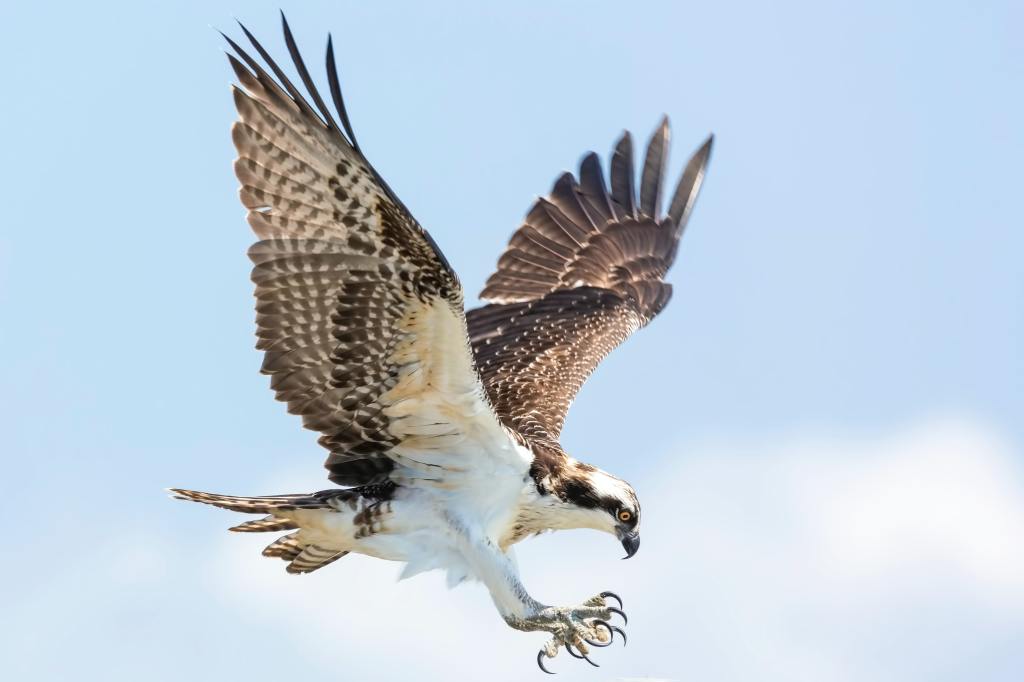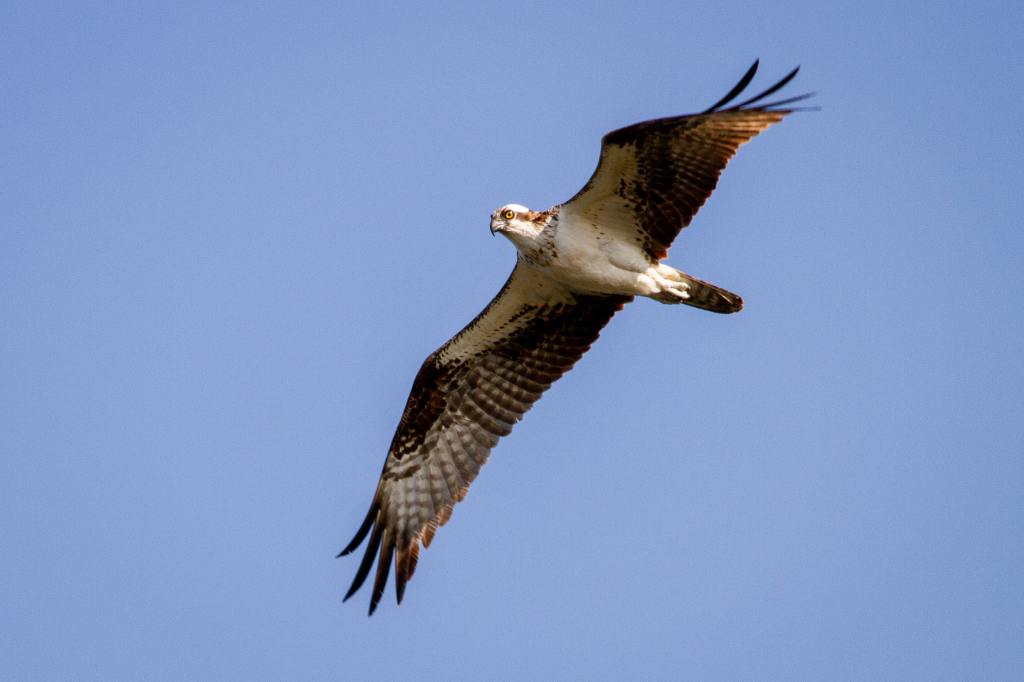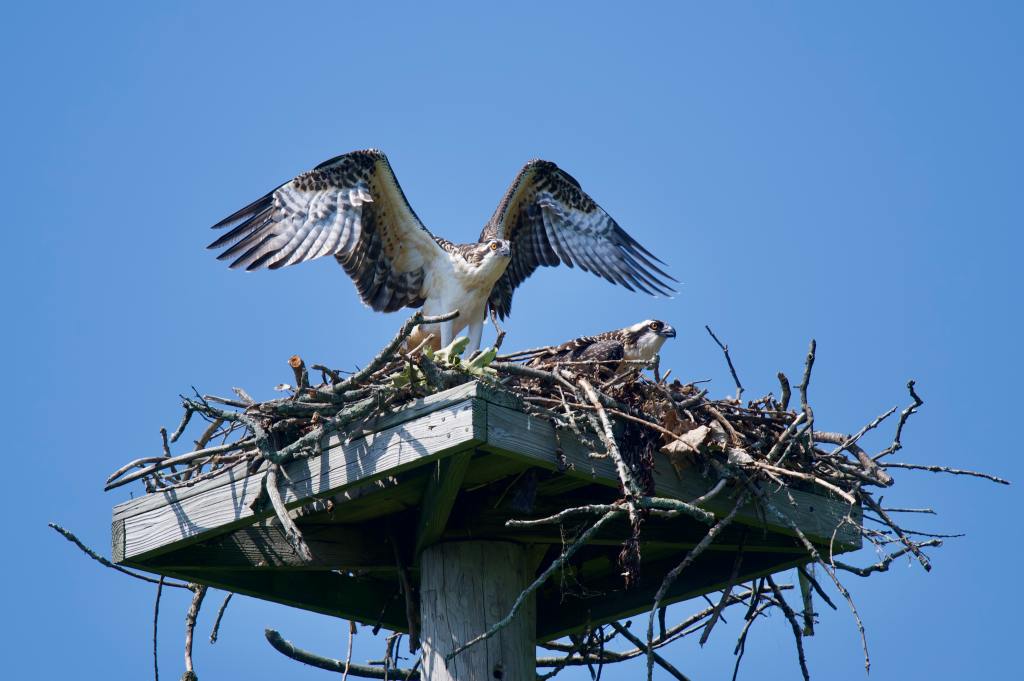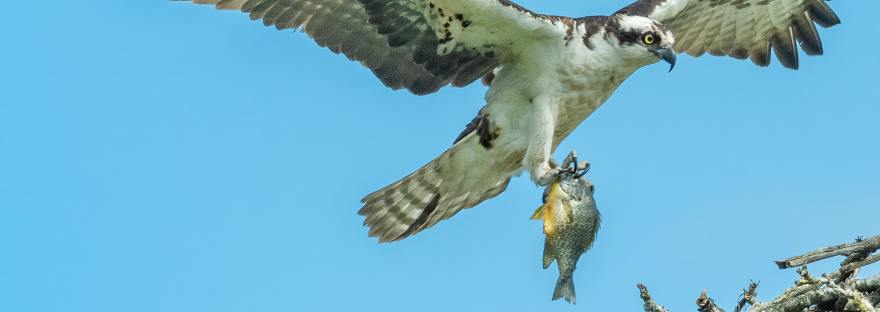Welcome to the first post in a brand new blog series I’m launching: Creature Feature!
And what better way to start this series other than with one of my all time favourite birds, the osprey!
This regal, yet also somehow, down to earth fish hawk is a special species for me. For several years I was an Osprey Monitoring Volunteer with Leicestershire & Rutland Wildlife Trust.
Watching ospreys for several hours every couple of weeks (along with all the other birds that share the reserve) turned me into a keen birder and cemented my growing passion and connection with nature.
I developed a deep attachment to Maya and 33 (named after his ring number), the celebrity pair at Rutland Water who are monitored all day everyday by dedicated volunteers. Since moving to Wales, I keep up with the intimacies of their lives over the spring and summer via webcam.
They are the face of the Trust’s osprey reintroduction project which began in 1996 with the translocation of chicks from Scotland. Rutland Water now has a self-sustaining population.

Ospreys are stunning birds of dark chocolate brown contrasting sharply with a white underside and head. A bandit mask stripe covers their shocking yellow eyes set above a curved black beak. Their chest has a necklace of brown speckles.
Seeing an osprey dive to the water’s surface claws outstretched then catching a fish is a magical sight.
In flight and perched, with their bodies set horizontal and their heads arching up to the sky, they look regal and even intimidating birds of prey. But on the ground and in their nests when rearranging twigs they can be awkwardand clumsy, making them somewhat comical.
Of course we should not anthropomorphise them but you can’t help but relate to 33’s apparent frustration when that branch won’t quite go where he wants it!
A combination of their stunning markings, personality, dedication to their chicks and expert skill at snatching up fish from the water made me fall in love with these magnificent birds of prey.

Osprey Facts
| Scientific name | Pandion haliaetus |
| Size | Length: 56cm Wingspan: 1.6m Weight: 1.5kg |
| Lifespan | 9 years on average but the oldest known osprey reached 32 |
| Habitat | Lakes, rivers and coastal areas |
| Range | Global |
| Food | Medium sized fish, both marine and freshwater |
| Conservation Status | Amber, in the UK due to low breeding numbers |
| When to see | March to September |
Ospreys used to be widespread across the UK but due to persecution became extinct in 1847 across most of Britain with strongholds remaining in Scotland. An end to persecution and reintroduction projects have brought them back to England and Wales.
Ospreys are specialists who only eat fish. To catch their prey they will soar up to 70 metres high gliding and briefly hovering to locate a suitable fish. Then they dive vertically raching as deep as a metre to catch the fish in their talons.
They have a reversible outer toe which helps them grab and hold onto their slippery prey. Ospreys can also close their nostrils when head first in the water.
Our ospreys visit for spring and summer to pair up and breed. They spend their winters in West Africa. Satellite tracking has shown them flying as far as 430km in a day. It usually takes them around 20 days to complete the journey stopping occasionally to feed.
Juveniles will stay in Africa for a couple of years before returning to find a nest and a mate.

Males are loyal to the sites where they were born, set to return every year. The larger females will range to new sites in search of a good location and a mate. Once paired up they usually stay faithful to each other and the nest.
They nest high up in large trees on a bed of branches and grass that they build up every year. Ospreys are happy to colonise artifical platforms made by us, making reintroductions and webcam filming easier!
The female lays 2 to 3 eggs which hatch after 37 days of incubation. Both parents work together to feed them. About 15 weeks after hatching the chicks are ready to fly to West Africa alone having never fended for themselves before.
Where you can see ospreys in the UK
Seeing ospreys on the nest or diving for fish is one of the UK’s most amazing wildlife experiences. There are several places where you can see ospreys with viewing platforms or even boat trips:
- Cors Dyfi, Wales
- Foulshaw Moss, England
- Loch Garten, Scotland
- Loch of the Lowes, Scotland
- Rutland Water, England
Or watch them live on the Rutland Water webcam!

How you can help UK ospreys
Ospreys still have a long way to go before recolonising the whole of the UK. You can help their progress by supporting reintroduction projects and wildlife charities:
- Donate to the Rutland Osprey Project
- Donate to Foulshaw Nature Reserve
- Donate to the Poole Harbour Osprey Project
- Support the Roy Dennis Wildlife Foundation
- Support the Osprey Leadership Foundation

Have you ever seen an osprey? What’s your favourite fact about them? Join the discussion below!
Subscribe to Wild & Green to receive future Creature Feature posts in your inbox!


Shames me to say I’ve only ever seen ospreys abroad! (Mainly the US). Desperate to see a British one…
LikeLiked by 1 person
Well they are much more common over there! I’m keen to see a Welsh one! I find it strange the US Ospreys don’t migrate when ours put so much effort into flying all the way to West Africa!
LikeLike
Congratulations, Sally. Looking forward to your new blog. They are such beautiful birds, sitting or flying. My favorite Osprey story, is when one defied all the contractors, carpenters, and just everyone on a building sight along the coast in North Carolina (USA). Everyday, they had to replace the wide yellow safety tape they put up to keep people off the sight, because an over zealous nest builder took a liking to it and kept stealing it for his nest. It was however, the most colorful nest in the sound that year. 🙂
LikeLiked by 2 people
Thank you 😊 That is such an amazing story, thank you for sharing! I can definitely imagine an Osprey doing that! 😆 Yesterday on Twitter I saw a photo of an Osprey carrying a stupidly long branch to its nest, I don’t even know how it had the strength to carry it and it was far too long to actually stay on the nest!
LikeLike
That’s funny! I’d love to see that. I’ve seen a couple carrying giant fish and I’ve wondered the same, and of course my camera battery decided to die at that very moment. Apologie,. I forgot to mention how much I loved your captures of this intriguing bird. I can find them fairly easily in some US states, and hardly at all in others so I loved seeing them here.
Penelope Penn
LikeLiked by 1 person
Thanks! Yeah I’m quite jealous that they are so common in some places in the US, here in the UK they are so exciting for people partly because they are so rare to see!
LikeLiked by 1 person
Lovely! Ospreys are one of my favourite birds too!
LikeLiked by 1 person
It’s nesting season here for our songbirds and I hope to get out soon to a favorite spot to see if the lone osprey that has chosen it the past 2 years has returned to his old nest to start a family as well It’s well worth the trip. Is it nesting season for yours in the UK as well? My yard is like LAX, with about 5 different species darting about feverishly, cris- crossing, choosing mates, then keeping others species from whichever nesting box they’ve chosen to adopt. I will keep fingers crossed for you, and will try to find the photo of yellow safety tape scoundrel to share for a laugh. Best of luck in your endeavors to increase your numbers there.
Penelope Penn
LikeLiked by 1 person
hi. I live in Sarasota Florida USA and have a VERY busy 3 Osprey, of what appears to be a family. I have video of them all sharing a meal of what I would guess was a squirrel or other bird ,(which they do eat regularly here) but it is VERY rare to see one eating on the ground. which I have also seen…but to get the video I caught is amazing…please contact me if you would like me to share to you
jen
j2m2m@yahoo.com
1-941-356-4553
LikeLiked by 1 person